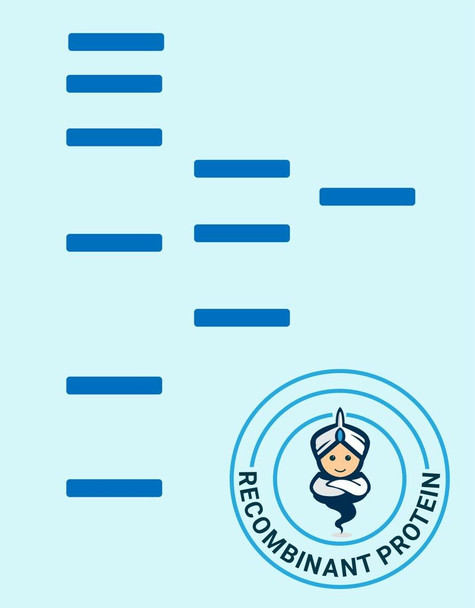HSA Protein Recombinant Protein (RPPB3890)
- SKU:
- RPPB3890
- Product type:
- Recombinant Protein
- Size:
- 500mg
- Species:
- HSA
- Target:
- Protein
- Synonyms:
- HSA
- ALB
- PRO0883
- PRO0903
- Source:
- Human Serum
- Uniprot:
- P02768
Description
| Product Name: | HSA Protein Recombinant Protein |
| Product Code: | RPPB3890 |
| Size: | 500mg |
| Species: | HSA |
| Target: | Protein |
| Synonyms: | HSA, ALB, PRO0883, PRO0903, PRO1341, DKFZp779N1935, GIG20, GIG42, PRO1708, PRO2044, PRO2619, PRO2675, UNQ696, SA, HSA. |
| Source: | Human Serum |
| Physical Appearance: | Sterile Filtered clear yellowish solution. |
| Formulation: | 0.2gr/ml solution containing no additives. |
| Stability: | HSA although stable at room temperature for 2 weeks should be stored at 4°C. |
| Purity: | Greater than 97.0% as determined by SDS-PAGE. |
HSA is synthesized in the liver as preproalbumin which has an N-terminal peptide that is removed before the nascent protein is released from the rough endoplasmic reticulum. The product, proalbumin, is in turn cleaved in the Golgi vesicles to produce the secreted HSA. HSA is a soluble, monomeric protein which comprises about one-half of the blood serum protein. HSA functions primarily as a carrier protein for steroids, fatty acids, and thyroid hormones and plays a role in stabilizing extracellular fluid volume. Mutations in this gene on chromosome 4 result in various anomalous proteins. HSA is a globular unglycosylated serum protein of molecular weight 65,000. The human HSA gene is 16,961 nucleotides long from the putative 'cap' site to the first poly (A) addition site. It is split into 15 exons which are symmetrically placed within the 3 domains that are thought to have arisen by triplication of a single primordial domain. HSA is widely used to stabilize blood volume generally from donors but the fear of contamination such as HIV & Hepatitis has enticed great interest in the recombinant form which is identical to the natural blood.Suitable for use in biochemical, excipient (an inert substance used as a diluent or vehicle for a drug), culture media and chromatographic applications.
HSA contains 584 amino acid residues derived from the prototypicalHSA sequence.
| UniProt Protein Function: | albumin: Serum albumin, the main protein of plasma, has a good binding capacity for water, Ca(2+), Na(+), K(+), fatty acids, hormones, bilirubin and drugs. Its main function is the regulation of the colloidal osmotic pressure of blood. Major zinc transporter in plasma, typically binds about 80% of all plasma zinc. Plasma. Belongs to the ALB/AFP/VDB family. 2 isoforms of the human protein are produced by alternative splicing. |
| UniProt Protein Details: | Protein type:Secreted; Carrier; Secreted, signal peptide Chromosomal Location of Human Ortholog: 4q13.3 Cellular Component: extracellular space; protein complex; extracellular region; basement membrane; nucleus Molecular Function:antioxidant activity; toxin binding; protein binding; copper ion binding; enzyme binding; DNA binding; zinc ion binding; chaperone binding; drug binding; oxygen binding; fatty acid binding; pyridoxal phosphate binding Biological Process: receptor-mediated endocytosis; platelet activation; sodium-independent organic anion transport; maintenance of mitochondrion localization; bile acid metabolic process; lipoprotein metabolic process; hemolysis by symbiont of host red blood cells; cellular response to starvation; response to mercury ion; bile acid and bile salt transport; response to organic substance; retinal homeostasis; platelet degranulation; transport; negative regulation of programmed cell death; blood coagulation; transmembrane transport; positive regulation of circadian sleep/wake cycle, non-REM sleep; response to nutrient; negative regulation of apoptosis Disease: Analbuminemia; Hyperthyroxinemia, Familial Dysalbuminemic |
| NCBI Summary: | Albumin is a soluble, monomeric protein which comprises about one-half of the blood serum protein. Albumin functions primarily as a carrier protein for steroids, fatty acids, and thyroid hormones and plays a role in stabilizing extracellular fluid volume. Albumin is a globular unglycosylated serum protein of molecular weight 65,000. Albumin is synthesized in the liver as preproalbumin which has an N-terminal peptide that is removed before the nascent protein is released from the rough endoplasmic reticulum. The product, proalbumin, is in turn cleaved in the Golgi vesicles to produce the secreted albumin. [provided by RefSeq, Jul 2008] |
| UniProt Code: | P02768 |
| NCBI GenInfo Identifier: | 113576 |
| NCBI Gene ID: | 213 |
| NCBI Accession: | P02768.2 |
| UniProt Secondary Accession: | P02768,O95574, P04277, Q13140, Q645G4, Q68DN5, Q6UXK4 Q86YG0, Q9P157, Q9P1I7, Q9UHS3, Q9UJZ0, |
| UniProt Related Accession: | P02768 |
| Molecular Weight: | Predicted: 67 kDaObserved: 57, 67 kDa |
| NCBI Full Name: | Serum albumin |
| NCBI Synonym Full Names: | albumin |
| NCBI Official Symbol: | ALB |
| NCBI Official Synonym Symbols: | FDAH; ANALBA; PRO0883; PRO0903; PRO1341 |
| NCBI Protein Information: | serum albumin; albumin (32 AA); albumin (AA 34); growth-inhibiting protein 20; cell growth inhibiting protein 42 |
| UniProt Protein Name: | Serum albumin |
| Protein Family: | Albumin |
| UniProt Gene Name: | ALB |
| UniProt Entry Name: | ALBU_HUMAN |










